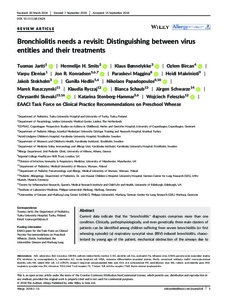Bronchiolitis needs a revisit: Distinguishing between virus entities and their treatments
EAACI Task Force on Clinical Practice Recommendations on Preschool Wheeze; Ozlem Bircan; Gunilla Hedlin; Chrysanthi Skevaki; Heidi Makrinioti; Katarina Stenberg-Hammar; Jakob Stokholm; Paraskevi Maggina; Klaudia Ryczaj; Varpu Elenius; Tuomas Jartti. Hermelijn H. Smits; Wojciech Feleszko; Jürgen Schwarze; Bianca Schaub; Jon R. Konradsen; Marek Ruszczynski; Nikolaos Papadopoulos; Klaus Bønnelykke
https://urn.fi/URN:NBN:fi-fe2021042720631
Tiivistelmä
Current data indicate that the “bronchiolitis” diagnosis comprises more than one condition. Clinically, pathophysiologically, and even genetically three main clusters of patients can be identified among children suffering from severe bronchiolitis (or first wheezing episode): (a) respiratory syncytial virus (RSV)-induced bronchiolitis, characterized by young age of the patient, mechanical obstruction of the airways due to mucus and cell debris, and increased risk of recurrent wheezing. For this illness, an effective prophylactic RSV-specific monoclonal antibody is available; (b) rhinovirus-induced wheezing, associated with atopic predisposition of the patient and high risk of subsequent asthma development, which may, however, be reversed with systemic corticosteroids in those with severe illness; and (c) wheeze due to other viruses, characteristically likely to be less frequent and severe. Clinically, it is important to distinguish between these partially overlapping patient groups as they are likely to respond to different treatments. It appears that the first episode of severe bronchiolitis in under 2-year-old children is a critical event and an important opportunity for designing secondary prevention strategies for asthma. As data have shown bronchiolitis cannot simply be diagnosed using a certain cutoff age, but instead, as we suggest, using the viral etiology as the differentiating factor.
Kokoelmat
- Rinnakkaistallenteet [19207]
